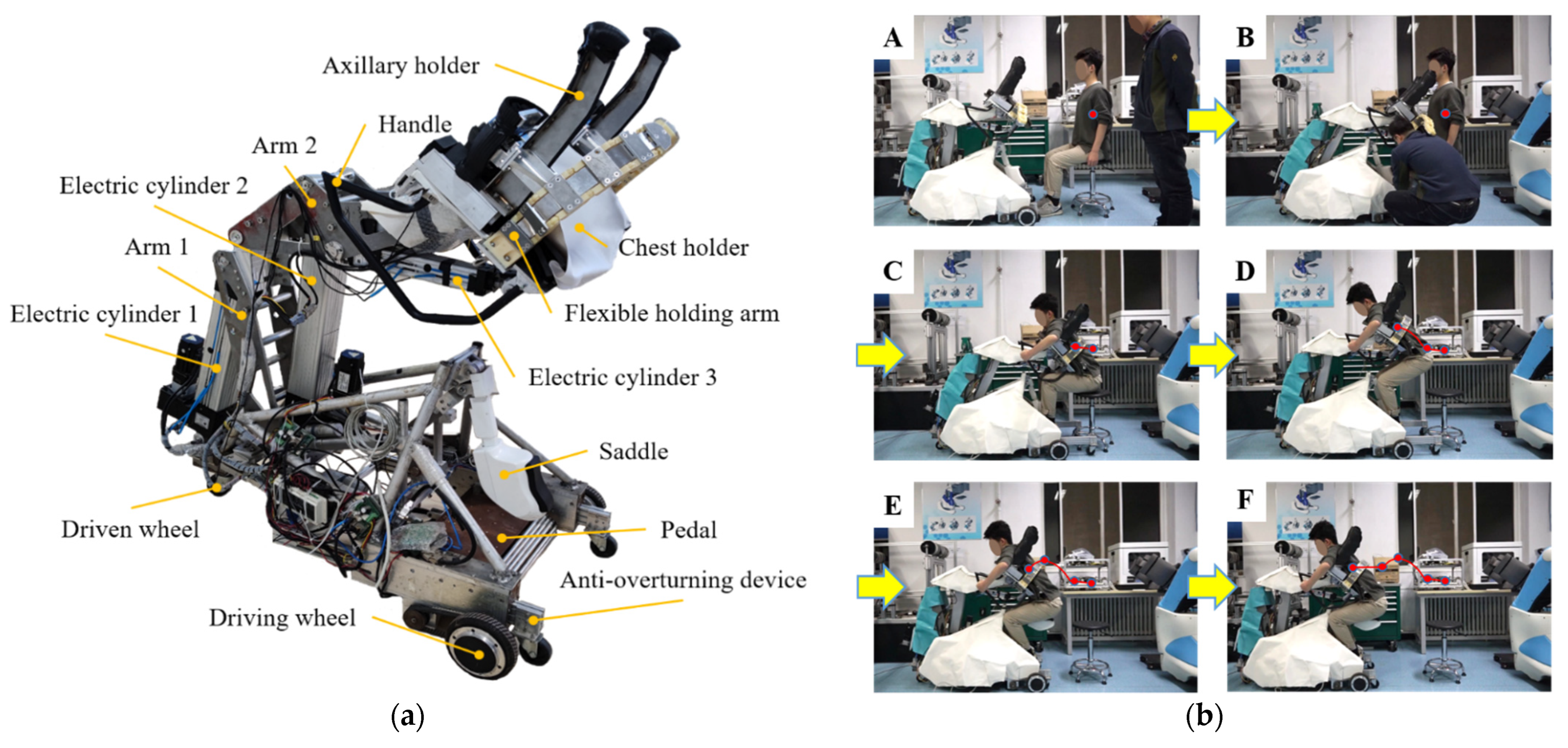To clarify the relationship between the force acting on the subject and the posture of the chest holder, a human-robot mechanics model was built, as shown in
Figure 4. In this model, the chest holder of the robot lifted a person from a seat. The person was regarded as a four-link model to simplify this model. In lifting, the chest, including the thorax and the abdomen, of the care-receiver was supported by the chest holder. The thorax and the abdomen were regarded as a whole, including the head and the neck. The pelvis and thigh were seen as a link. The calf and the foot were regarded as the other two links. Each link was articulated with each other. There were interaction forces in the joints of the links.
In lifting, the care-receiver’s chest, armpits, and foot are acting on some forces generated by their own gravity. Interaction forces also exist between the joints of the person. The piggyback nursing-care robot can lift a person with lower limb disability. Their arms are healthy, and they can hold the handle of the robot to ensure their posture in lifting. The grip of hands will reduce the force acting on the body. It is the internal force generated by muscles and different from the force acting on the body. To simplify the mechanics model and influence of the grip, the arms of the person and its weight were ignored in this model. The force acting on the armpits and the friction acting on the chest were regarded as a force. It was noted that there was no relative movement between the care-receiver and the chest holder of the robot in lifting, since the axillary holders of the robot supported the armpits of the care-receiver. Thus, the friction acting on the chest has little effect on the other force acting on the body and can be ignored. The force acting on the chest and foot of the care-receiver were regarded as a combination of force and moment, since they were in the area of contact with each other between the care-receiver and the robot. The size and force of the model are shown in
Figure 5a. The position and posture of the chest holder are represented by
, where
is the horizontal distance between the joint of the chest holder and the origin of the world frame,
is the vertical distance between the chest holder’s joint and the origin of the world frame, and
is the angle between the chest holder and the ground.
A fast lifting speed of the robot can increase the mental and physical burden on the care-receiver. To ensure the comfort of the person, the lift motion has a slow speed and a small acceleration. Therefore, the effect of inertial force acting on the person was ignored. The lifting motion was analyzed by using the statics analysis. According to the balance of forces and torques, the forces and torques acting on the foot meet:
where
is the weight of the foot.
and
are the friction and pressure exerted on the foot.
is the torque acting on the foot.
,
are the relative forces from calf to the foot.
represents the position of the mass center of the foot. The forces and torques acting on the calf meet:
where
is the weight of foot.
,
are the relative forces from the foot to the calf.
,
are the relative forces from thigh and pelvis to the calf.
is the angle between the calf and the ground.
is the length of the calf.
represents its position of barycenter. The forces and torques acting on the thigh and the pelvis meet:
where
is the weight of thigh and pelvis.
,
are the relative forces from the calf to the thigh.
,
are the relative forces from the abdomen to the pelvis.
is the angle between the thigh and the ground.
is the length of the thigh and the pelvis.
represents its position of the barycenter. The forces and torques acting on the torso (head, neck, chest, and abdomen) meet:
where
is the weight of torso.
,
are the relative forces from the pelvis to abdomen.
is the angle between the torso and the ground. It is equal to
).
is the length of torso.
represents its position of the barycenter.
and
are the force and torque acting on the chest (thorax and abdomen) of the care-receiver. The friction acting on the chest is not considered, because there is no relative movement between the chest and the chest-holder under the supporting of the axillary support.
is the force acting on the axillaries.
According to the Formulas (1)–(4) and the geometric relationship of the robot mechanism, the posture of the chest holder
is:
where
is the horizontal distance between the joint of the chest holder and the origin of the coordinate system,
is the vertical distance between the chest holder’s joint and the origin of the coordinate system, and
is the angle between the chest holder and the ground. (
,
) is the position of the ankle joint of the care-receiver. (
,
) does not change with different care-receivers, since each care-receiver put his/her foot on the same position in lifting. All parameters of the model are shown in
Table 1 [
26,
27].















